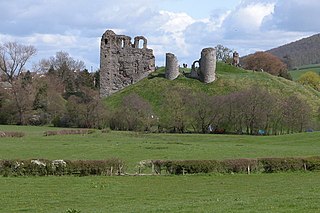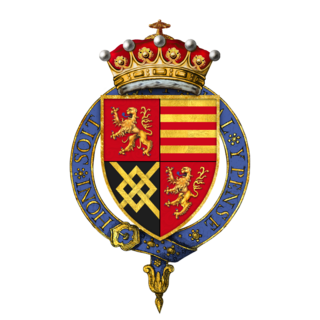This article relies largely or entirely on a single source .(March 2021) |
The title Baron FitzAlan has been created either once or twice in the Peerage of England.
This article relies largely or entirely on a single source .(March 2021) |
The title Baron FitzAlan has been created either once or twice in the Peerage of England.
The first creation was in 1295, when Bryan FitzAlan, Lord FitzAlan was summoned to Parliament as Lord FitzAlan. On his death in 1306, the peerage fell into abeyance between his two daughters.
In 1627 an Act of Parliament was passed “for the annexing of the Castle, &c., of Arundel, with the titles and dignities of the Baronies of FitzAlan, Clun and Oswaldestre and Maltravers, and with divers other lands, &c., being now parcels of the possessions of [him the said] Thomas, Earl of Arundel and Surrey, &c., to the same title, name, and dignity of Earl of Arundel.” "From this period, therefore, the Baronies of Clun and Oswestry (or Fitzalan of Clun and Oswestry), which hitherto had been mere feudal Lordships, may possibly be considered as Peerage dignities, and as being, together with Maltravers, annexed to the Earldom of Arundel." [1] Any Barony so created is held by the Duke of Norfolk.

The Duke of Norfolk is the premier duke in the peerage of England, and also, as Earl of Arundel, the premier earl. The Duke of Norfolk is, moreover, the Earl Marshal and Hereditary Marshal of England. The seat of the Duke of Norfolk is Arundel Castle in Sussex, although the title refers to the county of Norfolk. The current duke is Edward Fitzalan-Howard, 18th Duke of Norfolk. The dukes have historically been Catholic, a state of affairs known as recusancy in England.

The House of Stuart, originally Stewart, was a royal house of Scotland, England, Ireland and later Great Britain. The family name itself comes from the office of High Steward of Scotland, which had been held by the family scion Walter fitz Alan. The name "Stewart" and variations had become established as a family name by the time of his grandson, Walter Stewart. The first monarch of the Stewart line was Robert II, whose descendants were kings and queens of Scots from 1371 until the union with England in 1707. Mary, Queen of Scots was brought up in France where she adopted the French spelling of the name, Stuart.
John Fitzalan II (1223–1267), Lord of Oswestry, Clun, and Arundel, was an English nobleman and Marcher Lord with lands in the Welsh Marches.
Richard FitzAlan, 8th Earl of Arundel was an English nobleman and soldier.

John Fitzalan, 7th Earl of Arundel, 4th Baron MaltraversKG was an English nobleman and military commander during the later phases of the Hundred Years' War. His father, John Fitzalan, 3rd Baron Maltravers, fought a long battle to lay claim to the Arundel earldom, a battle that was not finally resolved until after the father's death, when John Fitzalan the son was finally confirmed in the title in 1433.

Edward William Fitzalan-Howard, 18th Duke of Norfolk,, styled Earl of Arundel between 1975 and 2002, is a British peer who holds the office of Earl Marshal. As Duke of Norfolk, he is the most senior lay peer in the peerage of England.

Clun Castle is a ruined castle in the small town of Clun, Shropshire. Clun Castle was established by the Norman lord Robert de Say after the Norman invasion of England and went on to become an important Marcher lord castle in the 12th century, with an extensive castle-guard system. Owned for many years by the Fitzalan family, Clun played a key part in protecting the region from Welsh attack until it was gradually abandoned as a property in favour of the more luxurious Arundel Castle. The Fitzalans converted Clun Castle into a hunting lodge in the 14th century, complete with pleasure gardens, but by the 16th century the castle was largely ruined. Slighted in 1646 after the English Civil War, Clun remained in poor condition until renovation work in the 1890s.
John FitzAlan III, 7th Earl of Arundel, was an English nobleman. He was also Lord and Baron of Clun and Oswestry in the Welsh Marches.
John Fitzalan, 3rd Lord of Clun and Oswestry (1200–1240) in the Welsh Marches in the county of Shropshire.
The title Baron Maltravers or Mautravers was created in the Peerage of England on 25 January and 23 October 1330 when John Maltravers was summoned to Parliament by writs directed Iohanni Mautravers Iuniori. The barony fell into abeyance among his granddaughters and coheirs, Joan and Eleanor, at his death on 16 February 1364. At the death of Joan without issue, Eleanor became, according to modern doctrine, de jure Baroness Maltravers. The barony later became a subsidiary title of the Earl of Arundel and subsequently the Duke of Norfolk.

William Fitzalan, 11th Earl of Arundel, 8th Baron MaltraversKG was an English peer, styled as Lord Maltravers from 1487 to 1524.
John Fitzalan or John FitzAlan may refer to:
Baron Arundel was a title in the Peerage of England created on 4 August 1377 by the summons of John Fitzalan to Parliament as "Johanni de Arundell". As he was then married to Eleanor Maltravers, coheir and eventual sole heir of John Maltravers, 1st Baron Maltravers, this is sometimes taken to be identical with the Barony of Maltravers. The barony subsequently came to be held by the Earl of Arundel, now itself a subsidiary title of the Duke of Norfolk.

FitzAlan is an English patronymic surname of Anglo-Norman origin, descending from the Breton knight Alan fitz Flaad, who accompanied king Henry I to England on his succession. He was grandson of the Seneschal of the Bishop of Dol. The FitzAlan family shared a common patrilineal ancestry with the House of Stuart.
A subsidiary title is an hereditary title held by a royal or a noble but which is not regularly used to identify that person, due to their concurrent holding of a greater title.
William FitzAlan may refer to:
Alice de Warenne, Countess of Arundel was an English noblewoman and heir apparent to the Earldom of Surrey. In 1305, she married Edmund FitzAlan, 9th Earl of Arundel.
Alice of Saluzzo, Countess of Arundel, also known as Alesia di Saluzzo, was an Savoyard noblewoman and an English countess. She was daughter of Thomas I of Saluzzo, and the wife of Richard Fitzalan, 8th Earl of Arundel. She assumed the title of Countess of Arundel in 1289.
Isabella Mortimer, Lady of Clun and Oswestry was a noblewoman and a member of an important and powerful Welsh Marcher family. Although often overshadowed in modern historiography by her better-known parents, she is now known to have played an important part in her family's struggles against Llywelyn ap Gruffudd and to have helped to secure the frontline at Shropshire in the run-up to English conquest of Wales. She was the wife and widow of John III FitzAlan, baron of Clun and Oswestry and de jure earl of Arundel. After a lengthy widowhood, she married for a second time and largely disappeared from the records.

John Maltravers, 1st Baron Maltravers (1290?–1364) was an English nobleman and soldier.